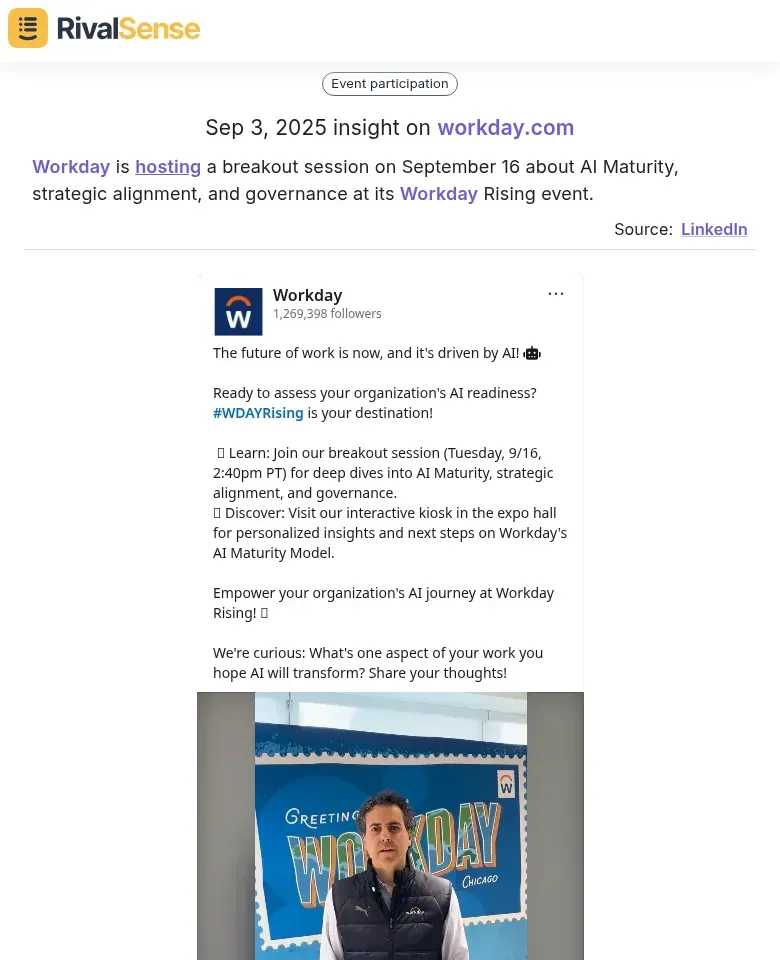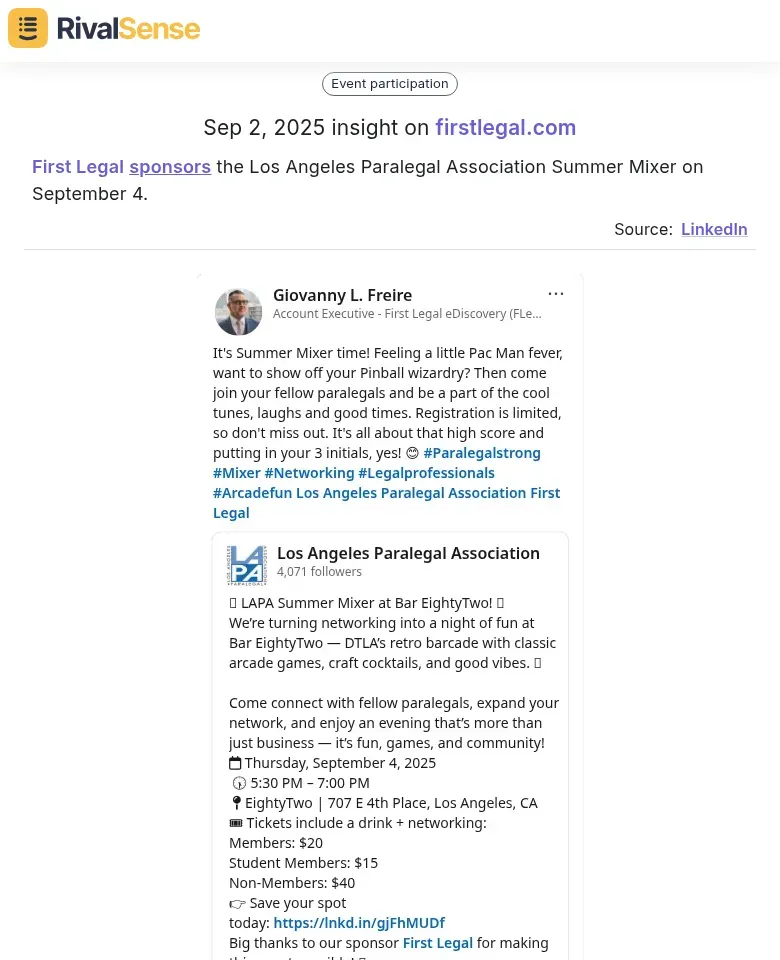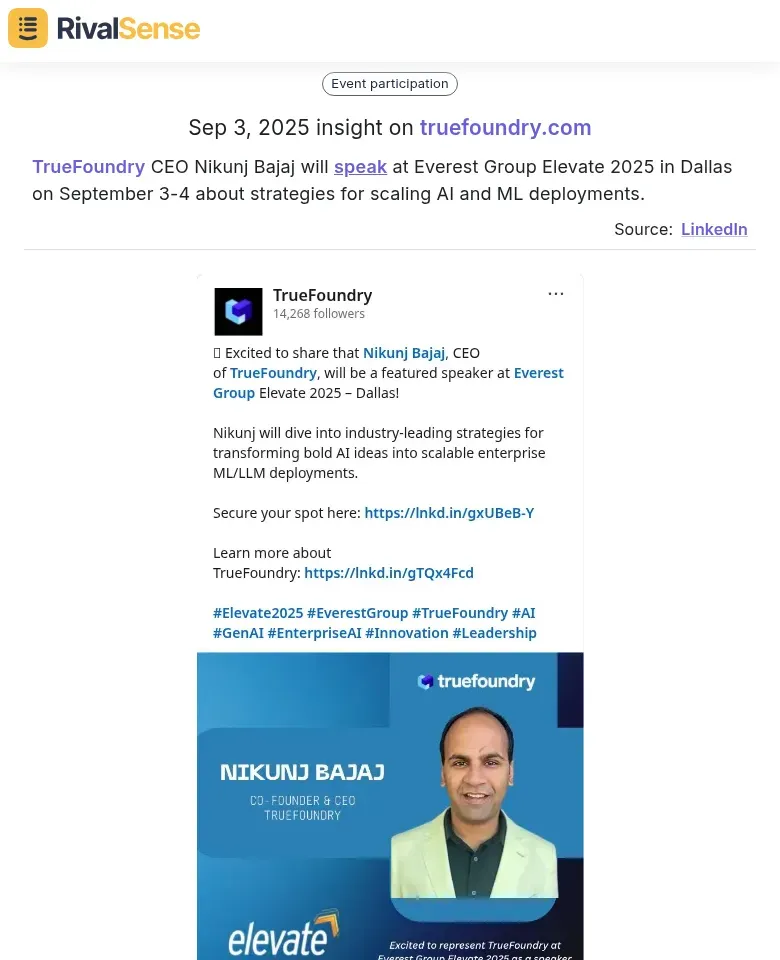Event Intelligence Workflow: Uncover Competitor Strategies for Key Account Loyalty
Event intelligence transforms how you understand competitor strategies and build key account loyalty. When competitors speak at industry events or sponsor conferences, they reveal their strategic priorities and market positioning. For example, if a rival consistently presents on AI-powered customer retention, they're signaling investment in that technology.
Practical steps: Create a tracking spreadsheet with columns for competitor name, event type, speaking topics, sponsorship levels, and dates. Set Google Alerts for "[competitor name] speaking" and "[competitor name] sponsor" to catch announcements. Monitor event websites 3-6 months before major industry conferences.
This intelligence provides early warning signals for market shifts. If multiple competitors suddenly focus on loyalty program partnerships, it indicates industry movement toward collaboration. For key account loyalty, use this intel to proactively address client concerns before competitors can position against you. Tip: Review competitor speaking abstracts—they often reveal upcoming product features or service enhancements months before launch.
Decoding Competitor Speaking Engagements: Strategic Insights from Conference Participation
Competitor speaking engagements offer a strategic window into their priorities before official announcements. Analyze presentation topics to identify focus areas—recurring themes like AI integration or sustainability signal emerging technology investments and strategic alignment.

Example: Workday's breakout session on AI Maturity reveals their strategic focus on artificial intelligence governance and implementation. This type of insight helps you anticipate their product roadmap and market positioning.
Map speaking patterns to understand thought leadership strategies. Track which executives present where—C-level appearances at premium events signal market positioning ambitions. Use this data to anticipate product launches and strategic initiatives 6-12 months ahead of public releases.
Practical steps:
✅ Monitor competitor event schedules via their websites and LinkedIn
✅ Create a tracking matrix with columns for event type, speaker level, key themes, and audience focus
✅ Analyze session recordings for messaging nuances and technical depth
✅ Identify gaps where your offerings can differentiate
✅ Integrate insights into quarterly strategy reviews
Pro tip: Focus on Q&A sessions—they often reveal unscripted strategic priorities that don't appear in prepared content.
Sponsorship Intelligence: Uncovering Competitor Relationship-Building Strategies
Sponsorship intelligence reveals competitor priorities through event patterns. Track which events rivals sponsor—industry conferences indicate B2B focus, while consumer expos target end-users. Analyze sponsorship tiers: platinum sponsorships signal major account investments, while bronze sponsorships suggest broader awareness campaigns.

Example: First Legal sponsoring the Los Angeles Paralegal Association Summer Mixer shows targeted investment in legal professional relationships. Sponsorship intelligence helps you understand where competitors are building strategic partnerships and which verticals they're prioritizing.
Practical steps:
- Create a competitor sponsorship tracker spreadsheet
- Monitor event websites and social media for sponsor announcements
- Note sponsorship levels and estimated investment ranges
- Identify geographic and industry patterns
- Cross-reference with account-based marketing efforts
Key insights: High-value sponsorships often precede enterprise account launches. If competitors sponsor niche events, they're likely targeting specific verticals. Budget allocation patterns reveal market priorities—heavy tech event spending indicates digital transformation focus.
Actionable tip: Set Google Alerts for competitor names + "sponsor" or "partner" to catch new developments. Use this intelligence to anticipate which accounts competitors will target next and strengthen your positioning accordingly.
Building Your Event Intelligence Workflow: From Data Collection to Actionable Insights
Building an effective event intelligence workflow requires systematic data collection, automated monitoring, and CRM integration. Start by identifying 10-15 key industry events, conferences, and trade shows relevant to your market. Create automated alerts for competitor speaking engagements, sponsorships, and attendance patterns.

Example: TrueFoundry CEO speaking at Everest Group Elevate 2025 about scaling AI deployments provides insights into their technical capabilities and market focus. Tracking executive speaking engagements helps you understand competitor expertise and thought leadership positioning.
Practical checklist:
✅ Map your ICP and target accounts in your CRM
✅ Set up real-time alerts for competitor event participation
✅ Integrate event intelligence tools with Salesforce or HubSpot
✅ Create automated workflows that trigger sales outreach 30 days pre-event
✅ Monitor competitor booth locations and speaking slots for strategic positioning
Integrate these insights directly into your CRM to trigger proactive engagement opportunities. When a key account registers for an event where competitors are presenting, automatically assign the account to your sales team with tailored talking points. This workflow ensures you're not just reacting to competitor moves but proactively engaging high-value accounts before competitors can influence them.
Turning Event Intelligence into Key Account Loyalty Strategies
Transform event intelligence into actionable key account loyalty strategies with this tactical approach. First, monitor competitor event participation patterns—when rivals consistently attend industry conferences where your key accounts are present, this signals targeted relationship-building efforts. Create a competitive vulnerability map: track which events competitors prioritize and identify gaps where they're absent, revealing opportunities for exclusive engagement.
Develop proactive counter-strategies: when competitors target events with your key accounts, deploy your executive team for personalized meetings, offer exclusive pre-event briefings, or create custom content addressing pain points competitors miss. If they're presenting solutions that overlap with your offerings, prepare counter-messaging highlighting your superior features or implementation success.
Practical checklist:
- Weekly review competitor event calendars
- Map key account attendance against competitor presence
- Prepare 3-5 talking points addressing competitor weaknesses
- Schedule executive outreach 2 weeks pre-event
- Post-event, analyze competitor engagement success through social media monitoring
This systematic approach turns competitive intelligence into strengthened account loyalty and preemptive relationship defense.
Measuring ROI and Scaling Your Event Intelligence Program
To measure ROI and scale your event intelligence program effectively, start by establishing clear KPIs that connect event insights to business outcomes. Track competitive win rates against key accounts, revenue influenced by event intelligence, and customer retention improvements. Implement a 30-60-90 day review cycle to assess impact on deal velocity and account expansion.
Build cross-functional workflows by creating a centralized event intelligence hub accessible to sales, marketing, and competitive teams. Establish weekly sync meetings where sales shares account-specific competitive threats identified at events, marketing provides campaign insights, and competitive intelligence teams deliver strategic analysis. Use shared dashboards to track competitor movements across global events in real-time.
Scale efficiently by implementing tiered monitoring: Tier 1 (top 3 competitors) gets real-time tracking, Tier 2 (next 5) receives weekly updates, and Tier 3 (emerging threats) gets monthly reviews. Leverage AI tools to automate data collection from multiple event sources and use geographic tagging to prioritize regional intelligence. Create standardized reporting templates that can be quickly adapted for different competitors and markets, ensuring consistent quality as you expand coverage.
Try RivalSense for Competitive Event Intelligence
Tracking competitor events manually can be time-consuming and unreliable. RivalSense automatically monitors competitor product launches, pricing updates, event participations, partnerships, and media mentions across multiple sources, delivering comprehensive weekly reports directly to your inbox.
Get your first competitor report today and start transforming event intelligence into competitive advantage. Try RivalSense for free at: https://rivalsense.co/
📚 Read more
👉 Business Partnership Best Practices: The Ultimate Strategic Guide for 2025
👉 Localize Semiconductor Partnerships: 5 Actionable Strategies for Growth
👉 How Barbour's Australia Expansion Triggered Competitive Responses (And How to Monitor Them)
👉 Instagram Competitor Analysis: Turn Insights Into Strategic Account Planning
